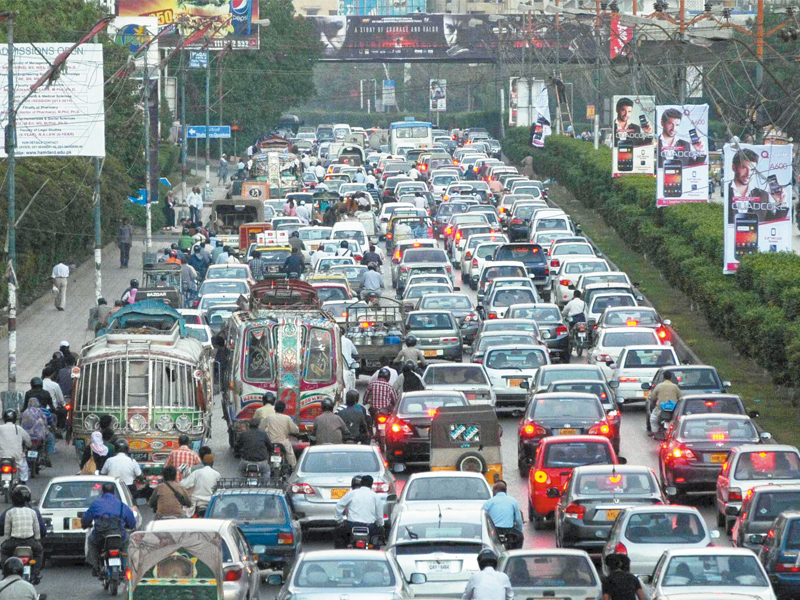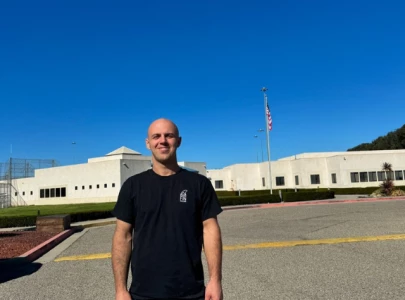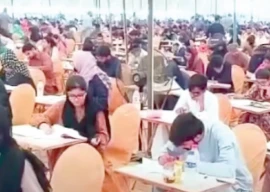
A city the size of Karachi, with an estimated population in the range of 20 million, is not served by a viable and decent public transport system. The transport infrastructure being developed, such as flyovers, helps people in private cars to move freely while making the commute of an already stressed and shamelessly transported common man in over-loaded, ill-maintained and rashly driven 'minibuses' and 'Chingqis' even more complicated.

According to a preliminary study in the African Journal of Biotechnology on fossil fuels consumptions and carbon dioxide emission in Karachi, the number of automobiles on the roads in Karachi is increasing with more emphasis on the use of private vehicles. Between 1990 and 2008, the observed growth in vehicles was comparatively greater than the population growth - with 1.1 million registered vehicles in Karachi in 2002 and 8.4 million in 2007. The observed growth during this time period, of nearly 656 per cent, far exceeds urban population growth.
These numbers are expected to grow exponentially. According to a 2009 study conducted by Japan International Cooperation Agency for the Karachi Circular Railway project, vehicle ownership in 2020 was estimated at 61.6 per cent. Assuming an average household has 3.9 members, the same study estimated that there will be seven million households in Karachi by the year 2020 with the number of vehicles owned will be nearly 4.3 million. This comes down to 156 vehicles for every 1,000 people.
Environmental concerns
And then, there are the environmental consequences. Pakistan's consumption of petroleum products is growing at an annual rate of approximately six per cent, almost half of which is consumed by the transport sector.
Vehicle-generated air pollution is severe, with high concentrations of fine and ultra fine articles in the air that can cause respiratory problems among a large number of Karachi's urban residents. The main sources of ambient air pollution in Karachi are old and ill-maintained vehicles, waste burning (8,000 tons of waste generated every day), re-suspended dust, and small scale businesses using 'dirty fuels' for manufacturing and production. Air pollution levels are extremely high by international standards and rising each year. The per day consumption of oil and petrol jumped from 16,000 barrels in 1980 to 51,000 barrels in 2007, with an increase of 219 per cent. This oil and petrol are mainly used in transport and power sectors.

Private vehicle usage is now globally being discouraged as a sustainable mode of transport given its adverse impacts on the environment and sustainable growth of urban settlements. A viable public transport system still remains a dream in Karachi so, for now, some initiatives taken at the citizens-level, such as using bicycles and carpooling, can make a dent and also create pressure to move towards public and sustainable modes of transport.
The writer is an urban planner and runs a non-profit organisation based in Karachi city focusing on urban sustainability issues. He can be reached at fanwar@sustainableinitiatives.org.pk
Be smart about travelling
Sustainable transport does not mean less transport than we have today, but it certainly means different transport. According to the Canadian Centre for Sustainable Environment, sustainable transport system is one that:
1. Is safe, consistent with human and ecosystem health, and with equity between generations
2. Is affordable, operates efficiently, offers choices, and supports a vibrant economy
3. Limits the emission of waste, minimises consumption of non-renewable resources, limits consumption of renewable resources, reuses and recycles components, and minimises use of land and production of noise
There are no major constraints for Karachi to achieve these standards, but this is only possible when the ‘common man’, the public transport user, the pedestrian starts emerging as a priority stakeholder in the proposed policies and plans. This is not only restricted to the transport sector but to the overarching urban planning and development framework in Karachi.
Published in The Express Tribune, December 23rd, 2013.
COMMENTS (4)
Comments are moderated and generally will be posted if they are on-topic and not abusive.
For more information, please see our Comments FAQ


1725612926-0/Tribune-Pic-(8)1725612926-0-165x106.webp)



1732176172-0/Untitled-design-(8)1732176172-0-270x192.webp)
1732175528-2/Untitled-design-(5)1732175528-2-270x192.webp)









totally agree with blogger! I have my own blog on this issue on qalamkarwan.com.Whenever I travell, I feel sick on looking my beloved city. All mafias should eradicate from here. http://www.qalamkarwan.com/2014/01/zarorat-hai.html
Karachi does not have a transport sector. Infact karachi has no sector whatsoever. Only mafias that hold the common man hostage, corrupt govt officials that endorse the mafias way of shady business and poor folk who try to make do whatever way they can till the end of their time.
transport sector...the last minister of transport was him self a big transporter same is the case of water...500 million Rs earned daily by hydrant Mafia...
Transport sector? You mean transport mafia. Until and unless a reliable, integrated public transit system where people feel safe and secure - like the one Mustafa Kamal tried to bring (Greenbus scheme) or like the one in Lahore - is established, KCR is revitalized and the Afghan transport mafia is forcibly kicked out, people will continue to buy whatever personal vehicles they can for their safety and convenience.
By the way, the results are also probably somewhat lopsided by the fact many people from the interior and smaller cities also buy vehicles from Karachi due to the price difference.